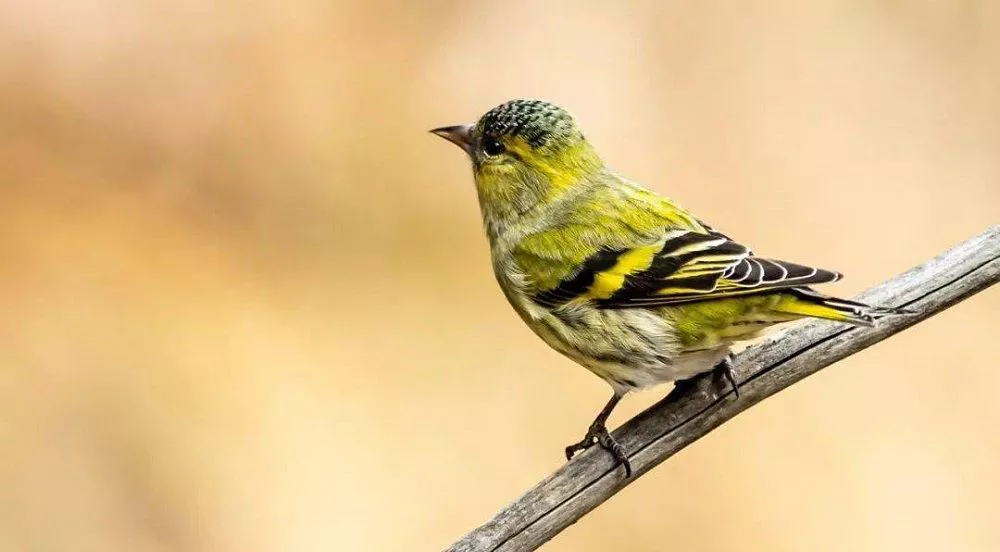The Eurasian siskin (Spinus spinus) is a small passerine bird that belongs to the finch family Fringillidae. Renowned for its melodious song and vibrant plumage, the Eurasian siskin is a cherished sight for birdwatchers and nature enthusiasts across the Northern Hemisphere. The Eurasian siskin have a lifespan of up to 10 years. In this article, we will delve into the characteristics, habitat, behavior, and ecological significance of the Eurasian siskin, highlighting its captivating presence in the avian world.
Physical Characteristics
Eurasian Siskins measure between 11-12.5 cm in length and weigh between 12-18 grams. The males have more vibrant coloration compared to female siskins. The male has bright yellow-green plumage while the female’s plumage is duller yellow-green. During breeding season, the male’s plumage becomes brighter as he seeks out a mate. Both sexes have a distinctive black cap, bib and wings with yellow stripes on the wings. Eurasian Siskins have a short, pointed bill that is well-suited for cracking open seeds.
Habitat and Distribution:
The Eurasian siskin is primarily found in coniferous forests across the Northern Hemisphere, including Europe, Asia, and parts of North Africa. These adaptable birds also inhabit mixed woodlands, mountainous regions, and occasionally visit urban gardens during colder months. They are known to undertake seasonal migrations, moving in search of abundant food sources. In winter, these birds move to lower elevations and can be found in gardens and urban parks.
Behavior and Feeding Habits:
Eurasian siskins are highly social birds, often observed in small flocks or mixed-species feeding groups. They are agile foragers, utilizing their specialized beak to extract seeds from various coniferous trees, such as spruce, pine, and fir. In addition to seeds, they also feed on buds, flowers, and occasionally insects. Their ability to hang upside down while feeding adds a charming element to their behavior.
Melodious Song and Vocalizations:
The Eurasian siskin is celebrated for its enchanting song, which is typically a melodious mix of high-pitched notes, trills, and warbles. The males are particularly renowned for their elaborate singing displays, often heard during the breeding season. These songs play a crucial role in establishing territories, attracting mates, and maintaining social bonds within the flock.
Breeding and Reproduction
Eurasian Siskins breed between April and July, with the peak breeding season occurring in May and June. The male performs a courtship display by flitting and fluttering his wings while singing a complex song to attract a mate. Once a pair bond is established, the female builds a cup-shaped nest made of twigs, grass, and moss. The nest is often located high up in trees, sometimes as high as 30 meters off the ground. Females typically lay 4-6 eggs that are incubated for around 13-14 days. Both parents participate in feeding and caring for the hatchlings until they fledge. The chicks fledge after around 15-20 days and become independent around 4 weeks after hatching.
Ecological Significance:
Eurasian siskins play a vital role in forest ecosystems. As seed-eaters, they contribute to seed dispersal, helping to regenerate and maintain healthy forest habitats. Their presence in coniferous forests also indicates the ecological health and abundance of suitable habitat.
Conservation Status and Threats:
Currently, the Eurasian siskin is not considered globally threatened, with stable populations across its range. However, habitat loss, fragmentation, and changes in land use practices pose potential threats to their long-term survival. Conservation efforts focus on preserving and restoring coniferous forests, ensuring the availability of suitable nesting sites and food sources for these beautiful songbirds.
Conclusion:
The Eurasian siskin stands as a remarkable songbird, captivating observers with its vibrant plumage, melodious song, and ecological significance. As it gracefully navigates coniferous forests, this charming finch leaves a lasting impression on birdwatchers and nature enthusiasts. By appreciating and protecting the habitat it relies upon, we can ensure the continued presence of the Eurasian siskin and cherish its delightful contributions to the avian world.
Related topics:


 Facebook
Facebook  Instagram
Instagram  Youtube
Youtube 